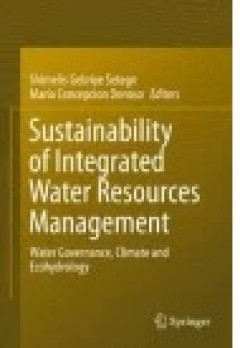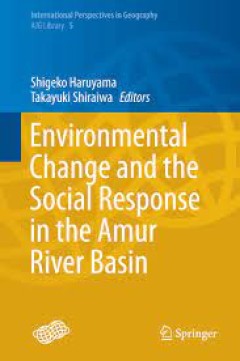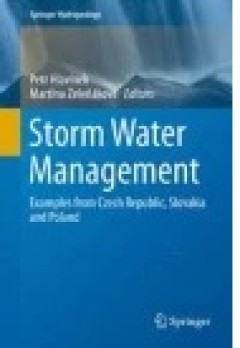Filter by

Toxic Pollutants in China
The book presents some of the findings of research into China’s water quality criteria for toxic pollutants, including heavy metals, PAHs and emerging pollutant. Water quality criteria (WQC) are the scientific basis for establishing water quality standards (WQSs). For a long time, the study of WQC in China has been neglected, so that almost all of China’s WQSs were developed based on foreig…
- Edition
- 1
- ISBN/ISSN
- 978-94-017-9795-5
- Collation
- VII, 140
- Series Title
- SpringerBriefs in Environmental Science
- Call Number
- -

Sustainability of Integrated Water Resources Management
This book will be of interest to researchers, practitioners, water resources mangers, policy and decision makers, donors, international institutions, governmental and non-governmental organizations, educators, as well as graduate and undergraduate students. It is a useful reference for Integrated Water Resources Management (IWRM), ecohydrology, climate change impact and adaptations, water gover…
- Edition
- -
- ISBN/ISSN
- 978-3-319-12194-9
- Collation
- XIV, 610
- Series Title
- -
- Call Number
- -

Environmental Management and Governance Advances in Coastal and Marine Resou…
This book deals with recent advances in coastal marine environmental management and governance. Various chapters consider new aspects of conservation, assessment of ecosystem health status, environmental survey and protection, frameworks of ocean service and governance, new applications of geo processing and GIS technology, beach management, aquaculture site selection, assessment of water quali…
- Edition
- -
- ISBN/ISSN
- 978-3-319-06305-8
- Collation
- 33 b/w illustrations, 120 illustrations in colour
- Series Title
- -
- Call Number
- -

Environmental Contaminants Using natural archives to track sources and long-…
The human footprint on the global environment now touches every corner of the world. This book explores the myriad ways that environmental archives can be used to study the distribution and long-term trajectories of chemical contaminants. The volume first focuses on reviews that examine the integrity of the historic record, including factors related to hydrology, post-depositional diffusion, an…
- Edition
- -
- ISBN/ISSN
- 978-94-017-9541-8
- Collation
- 58 b/w illustrations, 44 illustrations in colour
- Series Title
- -
- Call Number
- -

Environmental Change and the Social Response in the Amur River Basin
This book features research on historical land use and land cover in the Amur River Basin, which are important not only for residents there but also for those affected by its material and water cycles. Land use and land cover are affected by natural and human interactions over long and short timescales. The authors address historical changes in the land cover analysis of the Amur. The Amur regi…
- Edition
- -
- ISBN/ISSN
- 978-4-431-55245-1
- Collation
- 45 b/w illustrations, 76 illustrations in colour
- Series Title
- -
- Call Number
- -

A Global Overview of the Conservation of Freshwater Decapod Crustaceans
This book introduces updated information on conservation issues, providing an overview of what is needed to advance the global conservation of freshwater decapods such as freshwater crabs, crayfish, and shrimps. Biodiversity loss in general is highest in organisms that depend on intact freshwater habitats, because freshwater ecosystems worldwide are suffering intense threats from multiple s…
- Edition
- -
- ISBN/ISSN
- 978-3-319-42527-6
- Collation
- -
- Series Title
- -
- Call Number
- 333.72 GLO g

Storm Water Management
This book reviews the current state of the art in managing infrastructure, urban regions, industrial regions and inhabited areas with respect to flooding and water damage. The author is a well-known expert in storm water management, and this book gives a broad overview of the different manageable components that play a role in storm water risks. It includes chapters on planning infrastructure a…
- Edition
- -
- ISBN/ISSN
- 978-3-319-25835-5
- Collation
- X, 212
- Series Title
- -
- Call Number
- -

Engineering Geology for Society and Territory - Volume 6 Applied Geology for…
This book is one out of 8 IAEG XII Congress volumes, and deals with the theme of applied geology, which is a critical theme for the global economy. In the international, multidisciplinary approach to major engineering projects (either to macro- or mega-scale), the application of geological investigation techniques is fundamental for properly selecting the location sites, planning the constructi…
- Edition
- -
- ISBN/ISSN
- 978-3-319-09060-3
- Collation
- 189 b/w illustrations, 517 illustrations in colour
- Series Title
- -
- Call Number
- -

Engineering Geology for Society and Territory - Volume 3 River Basins, Reser…
This book is one out of 8 IAEG XII Congress volumes and deals with river basins, which are the focus of many hydraulic engineering and hydrogeological studies worldwide. Such studies examine river systems as both a resource of the fluvial environment, and also explore river-related hazards and risks. The contributions of researchers from different disciplines focus on: surface-groundwater excha…
- Edition
- -
- ISBN/ISSN
- 978-3-319-09054-2
- Collation
- 66 b/w illustrations, 324 illustrations in colour
- Series Title
- -
- Call Number
- -

Energy Use in Global Food Production Considerations for Sustainable Food Sec…
This Brief examines the sustainability of energy use in global food production and processing. The nexus between food, water, and energy are explored against a background of climate change. Current efforts to reduce the energy intensity of food and increase sustainability are explored. Food waste and its impact on energy is covered, including regional variations and nutrient recycling method…
- Edition
- -
- ISBN/ISSN
- 978-3-319-16781-7
- Collation
- 4 illustrations in colour
- Series Title
- -
- Call Number
- -
 Computer Science, Information & General Works
Computer Science, Information & General Works  Philosophy & Psychology
Philosophy & Psychology  Religion
Religion  Social Sciences
Social Sciences  Language
Language  Pure Science
Pure Science  Applied Sciences
Applied Sciences  Art & Recreation
Art & Recreation  Literature
Literature  History & Geography
History & Geography